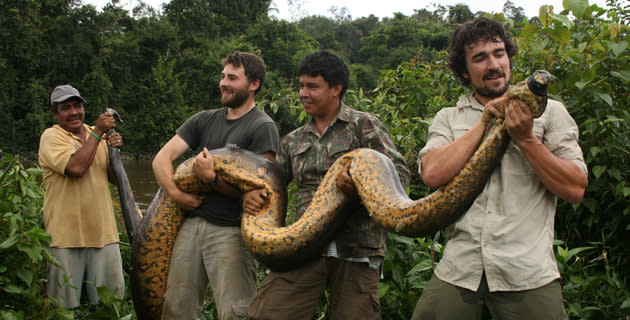Briton catches 18ft anaconda in South America
A British man has captured what is thought to be one of the largest snakes in the world.

Niall McCann, a 29-year-old biologist from Cardiff, snared the 18ft anaconda in the tropical rainforests of Guyana, South America, three weeks after he initially spotted the creature during his exploration with fellow traveler Dr Robert Pickles. The find occurred in 2009 but photos have only recently emerged.
The pair had initially set off to search for “giant otters” but came across a river teeming with wildlife - an area never before surveyed by scientists.
Speaking exclusively to Yahoo! News, Mr McCann said: “The animals there had never seen people before so you could get incredibly close to them”. Admitting that the Rewa River in central Guyana was “like the garden of Eden” he also revealed that during the three-week adventure across the river they spotted seven anacondas, four over 16 feet long.
Recalling the first time they saw the 18ft anaconda, the 29-year-old biologist described the behemoth as “frighteningly enormous”. Pulling up their boat beside the bank, McCann and Pickles climbed out to take a closer look. “When you first see something of that size you just don’t know how it will respond. We were very scared, we had heard innumerable horror stories of them taking people and killing them – you know this is a seriously dangerous animal you are faced with,” McCann said.
After taking photos from a safe distance they continued on, spotting the same snake three weeks later in the same spot. After going back up the river that night to camp they “felt confident having handled a lot of snakes and crocodiles in the previous three weeks,” coming to the decision to capture it the next day.
“We spent about 20 minutes preparing the landscape so we could encourage it to move inland, we didn’t want it to go into the river as it could have escaped,” McCann told Yahoo! News.
“It would stretch out then coil, ready to strike, then stretch out and coil again. I said, ‘right, next time it stretches I’m going to go for it’. It started to stretch out and I just leapt on top of it with both hands behind its head, my knee on its back and the other chaps piled on behind me”.
“It was a struggle for the first 30 seconds or so as it tried to move its head from side to side. It tried to scratch at us then Ash, the head guide, came round the front and grabbed it by the jaws as I lifted it up – wrapping its jaws with tape so it could no longer bite us”.
The intrepid explorers then ensured the anaconda could not escape with its jaw taped shut as it would not survive in the wild - a circumstance that McCann admitted would have been “very upsetting for us”. After measuring the anaconda they then freed its jaw – allowing it to escape.
“We were doing it for scientific purposes but I can’t lie, we were also having an adventure,” McCann admitted. “This is the largest snake in the world, it is a pretty amazing thing to do as a biologist to get close to one let alone handle one. There is something primordially intimidating about the appearance of an anaconda- especially one of those proportions”.
Research continues after McCann helped set up a British based conservation project in the area.

 Yahoo News
Yahoo News 
